When I was a kid and drove with my father from our hometown of Lowell, Mass to the orthodontist in Boston, we would go through the streets of Cambridge. I would notice the rather decrepit looking triple deckers, the small apartment buildings, the dirty streets – and the dark faces. I remember questioning my father and asking why people had to live that way.
Then came college and as a child of the sixties, I did my small bit for the neighborhood not far from Brown University: tutoring inner city kids, protesting in November 1963 when George Wallace spoke at Brown, joining SNCC until whites were no longer welcome.
Bits and pieces of my life intersected with the idea of the Civil Rights movement but the reality of marriage, motherhood and career took over. However, my check book was always at the ready.
The Shomrei Civil Rights trip was a poultice for my soul: I always have regretted that I was too naïve, uninformed, scared, caught up in a summer job that provided college expenses, to get more involved in social issues broader than those in my own community.
I spent a couple of days exploring Atlanta with my elder daughter. We went to the High Museum, Atlanta’s fine arts museum, where one of the featured exhibits showcased photographs of the South from pre Civil War through contemporary years. Photos showed both poverty and prosperity, people and places, pride and prejudice.
Though seeing the exhibit was serendipitous, it was a perfect introduction to the trip.
Right near the hotel was the campus which included the Coca Cola Museum, the Atlanta Aquarium, and the heart-stopping National Center for Civil and Human 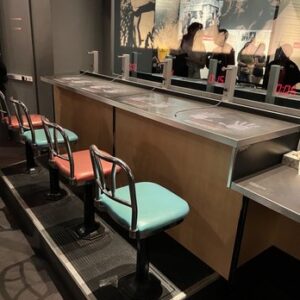 Rights. Three themes are covered in the center: Martin Luther King, Jr’s papers including the draft of the Letter from Birmingham Jail, a look at the global human rights movement through an exhibit that contrasts dictators and autocrats with human rights activists, and on the ground floor the story of the American civil rights movement. Not to be missed is the immersive lunch counter where one sits at the counter with eyes closed, dons earphones and experiences what it was like to be vilified for sitting on a revolving plastic covered stool. Many people left in tears.
Rights. Three themes are covered in the center: Martin Luther King, Jr’s papers including the draft of the Letter from Birmingham Jail, a look at the global human rights movement through an exhibit that contrasts dictators and autocrats with human rights activists, and on the ground floor the story of the American civil rights movement. Not to be missed is the immersive lunch counter where one sits at the counter with eyes closed, dons earphones and experiences what it was like to be vilified for sitting on a revolving plastic covered stool. Many people left in tears.
And then we began…
Sunday morning after visiting MLK, Jr’s tomb, we attended The Ebeneezer Baptist Church service. The congregation was welcoming. To see the Shomrei group, go to approximately 1:26 on the link to the recording. (https://livestream.com/historicebenezerbaptistchurch/events/11017078/videos/238479532)
Then off we went to Montgomery, the capital of Alabama. One might expect a capital city to be bustling and prosperous looking. Montgomery was neither.
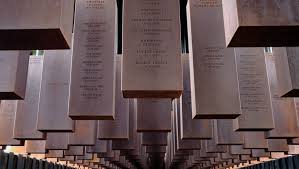 But our stop in Montgomery was indelible. The Equal Justice Initiative’s Memorial to Peace and Justice is a stark, dark, chilling (just like the weather that afternoon) memorial to victims of lynching. And by the way, New Jersey is not exempt. Nor were whites.
But our stop in Montgomery was indelible. The Equal Justice Initiative’s Memorial to Peace and Justice is a stark, dark, chilling (just like the weather that afternoon) memorial to victims of lynching. And by the way, New Jersey is not exempt. Nor were whites.
The visitor walks through a “forest” of plinths engraved with counties, names of victims if known and dates of lynching. As the walker descends through the installation, the plinths seem to get higher as if they were bodies swinging from a limb. Finally, they hang high above the viewer’s head. At the very end there is another installation of coffin shaped tablets, bringing the dreadful cycle to its end.
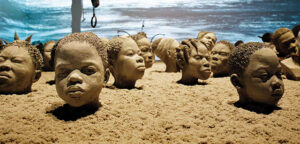 Equal Justice Initiative’s Legacy Museum is just across the road. It traces the history of slavery in very graphic terms beginning with an installation of ocean waves washing over heads of Africans buried in sand. The Equal Justice Initiative is Bryan Stevenson’s (Just Mercy) concrete expression of his philosophy and efforts.
Equal Justice Initiative’s Legacy Museum is just across the road. It traces the history of slavery in very graphic terms beginning with an installation of ocean waves washing over heads of Africans buried in sand. The Equal Justice Initiative is Bryan Stevenson’s (Just Mercy) concrete expression of his philosophy and efforts.
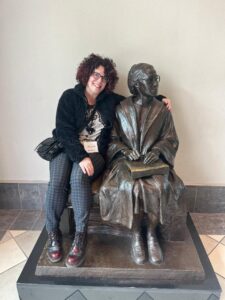 Montgomery is also the home of the Rosa Parks Museum. How impressive was Parks’s quiet dignity and the stubbornness of the Montgomery boycotters as they walked, biked, took cabs, and carpooled for over a year as they refused to board the public buses. But they persisted and won.
Montgomery is also the home of the Rosa Parks Museum. How impressive was Parks’s quiet dignity and the stubbornness of the Montgomery boycotters as they walked, biked, took cabs, and carpooled for over a year as they refused to board the public buses. But they persisted and won.
Our next stop was Selma, a depressed city of about 30,000 people whose reputation belies its size. The once thriving town has never recovered from hurricane damage. Closed stores, empty streets, and a beautiful synagogue with a membership of 3 leave an indelible impression of how times have changed.
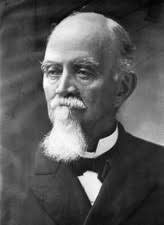 Selma is where some of the most pivotal events of the Civil Rights movement took place and the location of the famous Edmund Petttus Bridge, named after a former Confederate brigadier general, U.S. senator, and state-level leader (“Grand Dragon”) of the Alabama Ku Klux Klan. There have been proposals to rename the bridge in honor of John Lewis but he objected feeling that the current name was a stronger memorial to the events of Bloody Sunday. The bridge, by the way, is functionally obsolete – not up to today’s standards.
Selma is where some of the most pivotal events of the Civil Rights movement took place and the location of the famous Edmund Petttus Bridge, named after a former Confederate brigadier general, U.S. senator, and state-level leader (“Grand Dragon”) of the Alabama Ku Klux Klan. There have been proposals to rename the bridge in honor of John Lewis but he objected feeling that the current name was a stronger memorial to the events of Bloody Sunday. The bridge, by the way, is functionally obsolete – not up to today’s standards.
 The experience of walking over that bridge after just having heard Linda Blackmon Lowery speak of her experience as a teenager, brought the brief walk to life. The phalanx of troopers, dogs and hoses almost appeared to be there- as they were for Lowery – when we walkers crested the bridge. But we were just walking and on the other side found not hateful shouts and snarling dogs but our warm bus and friendly driver who drove us next to Birmingham, Alabama’s largest city.
The experience of walking over that bridge after just having heard Linda Blackmon Lowery speak of her experience as a teenager, brought the brief walk to life. The phalanx of troopers, dogs and hoses almost appeared to be there- as they were for Lowery – when we walkers crested the bridge. But we were just walking and on the other side found not hateful shouts and snarling dogs but our warm bus and friendly driver who drove us next to Birmingham, Alabama’s largest city.
Our first stop was Freedom Park across the street from the 16th Street Baptist Church where 4 young girls died in a Sunday morning bombing. The park is dotted with statues of the girls, tributes to Civil Rights efforts.
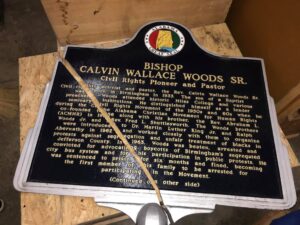 Here we stood and listened,fascinated, to 90-year-old Bishop Calvin Woods, Sr who talked, preached and sang us through his work as a civil rights leader decades ago. His indomitable spirit came through as vibrantly as his purple suit and coordinating tie. This plaque dedicated to Bishop Woods was damaged a few years ago showing that hate has not died.
Here we stood and listened,fascinated, to 90-year-old Bishop Calvin Woods, Sr who talked, preached and sang us through his work as a civil rights leader decades ago. His indomitable spirit came through as vibrantly as his purple suit and coordinating tie. This plaque dedicated to Bishop Woods was damaged a few years ago showing that hate has not died.
Through artifacts, The Birmingham Civil Rights Museum pulled it all together and allowed us to reflect upon the entire trajectory of the Black experience.
And so many other memorable events and conversations filled those three days. All were enhanced by our affable and knowledgeable guide Avi, the detailed oriented care of Risa Bernstein, the insightful comments and questioning of Dale Russakoff and the leadership of Rabbi Julie.
As I’ve processed those days and put all the parts together, I have no words to express my awe at the bravery of the young and old who put their lives on the line.
I have no words to express my despair at the hatred that one group of Americans had for another and the ways in which they perverted the law and kept the system going despite the law.
I have no words to show the disappointment I have in what MLK called the “appalling silence of good people” as quoted by Drew Gilpin Faust at Bryn Mawr College where she was a student.
And sadly, I must admit how fortunate that even in these fraught days when it is difficult to be a Jew, I am white and can hide behind my whiteness.
May we all find the strength to not only be good people but also have the courage to speak out when we see injustice.
Readings:
Eig, Jonathan, King: a Life. A detailed biography of the civil rights, leader warts and all.
Kix, Paul, You have to be prepared to die before you can begin to live: ten weeks in Birmingham that changed America. Kix focuses on both events and people in this readable study of people and power.
Drew Gilpin Faust, Catharine, Necessary Trouble. The former president of Harvard, raised in Virginia horse country, educated at segregated schools and elite Concord Academy, tells about growing up during the Civil Rights struggle through her activist college days at Bryn Mawr.
Simmons, Ruth, Up Home. The former president of Brown University, grew up in Texas very poor and very Black. Through a mentoring teacher, she was encouraged to get an ed-ucation and escaped the fate of many of her contemporaries who were caught in the sharecropping system.
NOTE: Faust and Simmons were born 2 years apart but lived very different early lives.
- Not By Brains Alone - Thu, Jul 18, 2024
- Kudos to the Lampert Library - Thu, Jun 27, 2024
- Dairy Dishes Not Just for Shavuot - Fri, Jun 14, 2024

Aileen, Thank you for sharing your thoughts as you process this powerful trip. I hope others on the Shomrei Civil Rights trip will also share some of their impressions. Andy and I took a similar trip on our own in 2018 and some of the images still haunt us. Merrill
Thank you, Aileen, for giving us a glimpse of all the memorable places you visited. Your summary is very powerful.
Thank you Aileen. As always, your words are a gift. ❤️Shirley
Thank you, Aileen, for this succinct and thoughtful summary of the Civil Rights Trip and for bringing all the pieces together so beautifully. Judy
Montclair in the 60’s was a time of great discomfort between those who lived north of Bloomfield Ave. and those who lived south of the avenue.
My maid’s son, Billy, was shot (in the back) and killed by the militia while he was demonstrating in Newark.
When I with my children, brought food to his family, I was warned that I was entering dangerous territory. Billy’s family welcomed me and thanked me for bringing them dinner.